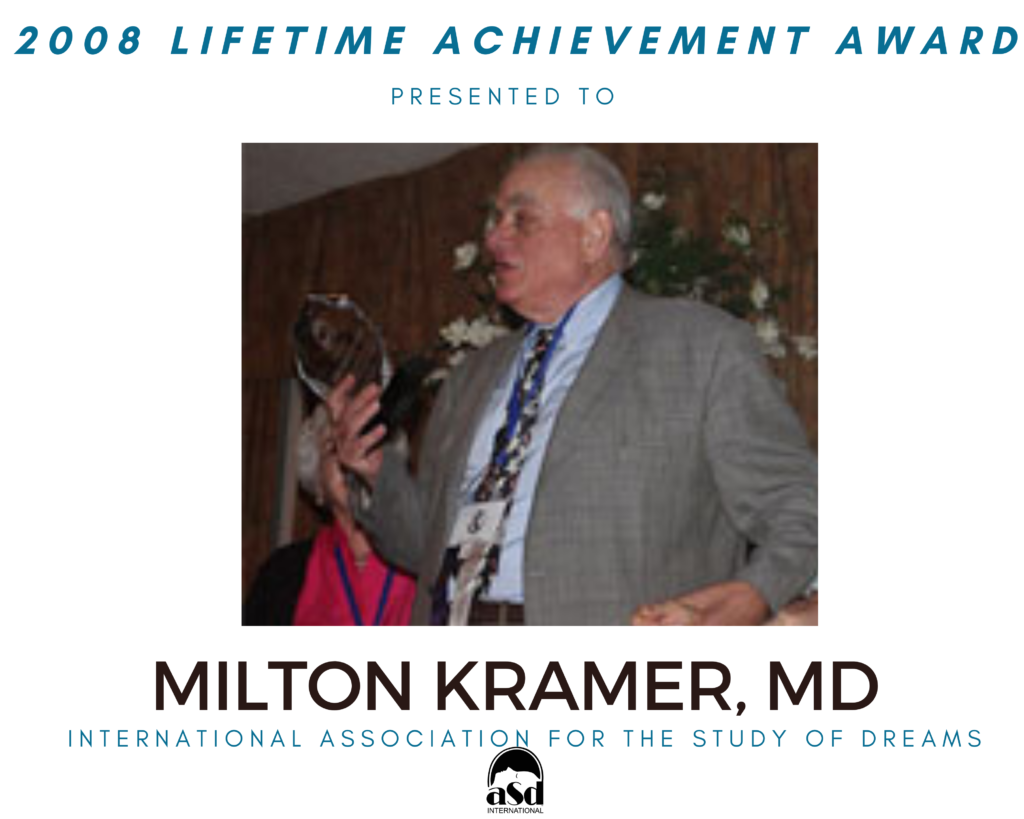
| Milton Kramer, MD 2008 IASD Lifetime Achievement Award Winner Personal Profile I have had the opportunity to spend 48 years of my academic career involved in dream research. I came out of the Army in 1960 and joined the NIMH-funded dream research group at the University of Cincinnati, where I had had my psychiatric residency. The group was lead by Roy Whitman and was utilizing EEG techniques to identify REM sleep and recover dreams. In 1962, I published my first dream paper, “Which Dream Does the Patient Tell?” It was in this context that I had my grounding in dream research with Whitman, Bill Baldridge and Paul Ornstein. I was working at the Cincinnati VA Hospital as my department job and in 1963 got VA support to open a sleep/dream lab at the hospital. We did work confirming the reliability of the Hall-Van de Castle scales applied to laboratory collected dreams and collecting the data that was the base for the mood regulatory theory of sleep and dreams. I held a NIMH supported conference in 1967, which I published in 1969 as “Dream Psychology and the New Biology of Dreaming.” I invited all the people whose work I had been reading: Aron Beck, Walter Bonime, Roz Cartwright, Bill Domhoff, Harry Fiss, Calvin Hall, Dave Hawkins, Richard Jones, Robert Langs, Carl Meier, William Offenkrantz, Harold Sampson, Edith Sheppard, Fred Snyder, Charles Tart, Harry Trosman, Monte Ullman, Bob Van de Castle and Hy Witkin. Many of them became close professional colleagues and friends. It became clear that without a standardized, reliable scoring system for dream content analogous to the Rechtshafen/Kales manual for sleep, progress in the scientific study of dreaming would not be possible. We discussed this with colleagues at the 10th annual meeting of the Sleep Society [APSS] in Santa Fe and were discouraged from such an effort as premature by Al Rechtschafen. This led to Carolyn Winget and I writing a book on quantitative approaches to dreaming including with descriptions some 130 scales and a tabular summary of the quantitative dream literature. We published it as Dimensions of the Dream in 1979 with the help of David Foulkes. It was in 1986 that Gayle Delaney approached me to see if I would be interested in becoming President of the newly formed Association for the Study of Dreams. My efforts through the Sleep Society to encourage more presentations on dreams had not led to greater productivity although dream reports were over-represented on the program as not much was being submitted. I accepted Gayle’s offer and served as President from 1987-88. It put me in touch with people like Gayle, Loma Flowers and the dream workers such as Rita Dwyer. It has been an experience that opened my eyes to the incredible impact that the intimacy of dream sharing could and does have. To see the magic of a Gene Gendlin, Gayle, and others make contact with a stranger through exploring the dream makes the entire experience worthwhile. On the more traditional side, spending time with so many wonderful Canadian dream researchers like the late Al Moffitt with whom in 1993 I edited The Functions of Dreams, Don Kuiken, Tore Nielsen and others was exciting. Canada is where the study of dreams has found a home. |
| I was pleased that those of us interested in the disciplinary base for dream researchers had a national organization in ASD. Then happily SUNY Press started a dream book series and asked Bob Van de Castle to be its editor. What was needed was a journal to complete the necessary triad and that came to fruition with the start of Dreaming with Ernie Hartman as its first editor. An academic career was possible with dreams as one’s topic area. In 2007 I published a summation of my work The Dream Experience which led me back through the work I did and vividly recalled for me the people who stimulated and encouraged me. Currently I am working with the former Director of the Psychoanalytic Institute at the New York Medical College, Buddy Glucksman. We have published work on dreams reflecting who benefited from therapy and the frequency of emotions in dreams. We currently are looking at the dreams of his patients to see if their initial problems are age-related.The future for me in dream research remains uncertain as does so much when you are 79. But the promise is in the work and in my colleagues. |
